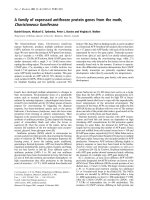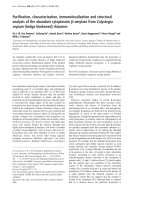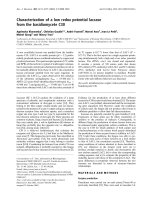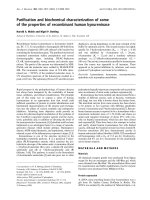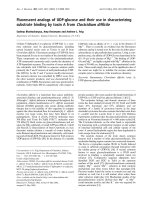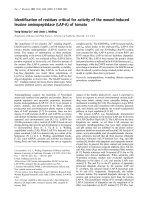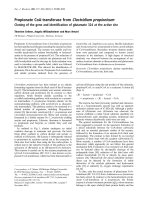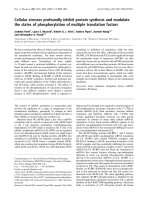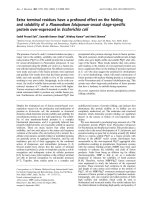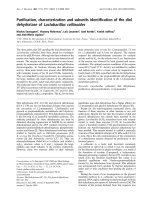Báo cáo y học: " Always one step ahead: How pathogenic bacteria use the type III secretion system to manipulate the intestinal mucosal immune system" doc
Bạn đang xem bản rút gọn của tài liệu. Xem và tải ngay bản đầy đủ của tài liệu tại đây (3.5 MB, 10 trang )
REVIEW Open Access
Always one step ahead: How pathogenic bacteria
use the type III secretion system to manipulate
the intestinal mucosal immune system
Anna Vossenkämper
*
, Thomas T MacDonald and Olivier Marchès
Abstract
The intestinal immune system and the epithelium are the first line of defense in the gut. Constantly exposed to
microorganisms from the environment, the gut has complex defense mechanisms to prevent infections, as well as
regulatory pathways to tolerate commensal bacteria and food antigens. Intestinal pathogens have developed
strategies to regulate intestinal immunity and inflammation in order to establish or prolong infection. The
organisms that employ a type III secretion system use a molecular syringe to deliver effector proteins into the
cytoplasm of host cells. These effectors target the host cell cytoskeleto n, cell organelles and signaling pathways.
This review addresses the multiple mechanisms by which the type III secretion system targets the intestinal
immune response, with a special focus on pathogenic E. coli.
Keywords: gut-associated lymphoid tissue type 3 secretion system, EPEC, Shigella
Review
The gut-associated lymphoid tissue
The intestinal lumen is exposed to the environment and
therefore in continuous contact with harmless as well as
pathogenic microorganisms. Thus, it is not surprising
that the gut is the biggest lymphoid organ in the body
and contains about 70% of the body’ s i mmune cells
[1-3]. The gut-associated lymphoid tissue (GALT) uses a
range of mechanisms to protect the host from p atho-
gens, while it at the same time tolerates commensal
microorganisms. Furthermore, the GALT needs to pre-
vent the invasion of harmful agents without affecting
the absorption of nutrients from the lumen.
GALT is comprised of the appendix, single lymphoid
follicles (Figure 1) in the small and large intesti ne, and
the Peyer’s patches (PP). The latter are clusters of folli-
cles and have a distinct architecture with germinal cen-
ters containing B cells and follicular dendritic cells
(DCs) which are surrounded by areas with T cells and
macrophages [2]. PP are covered by specialized micro-
folded epithelial cells, the M-cells, which make up the
follicle-associated epithelium (FAE). This epithelium
forms the interface between the luminal microorganisms
and the immune cells of the G ALT [4]. PP have no
afferent lymph vessels and antigens are received directly
from the intestinal lumen. After the uptake of luminal
material by endocytosis and phagocytosis, the M-cells
deliver antigens and microbes to antigen-presenting
cells in the subepithelial dome of the PP, which subse-
quently present them to PP T cells [2]. PP DCs also
directly sample bacteria from the intestinal lumen by
sending protrusions through the epithelia l layer without
disrupting epithelial integrity [5]. Ther efore, follicles and
PP are an inductive site where microorganisms are
sensed and the appropriate immune response is initiated
[4]. In contrast, the lamina propria is an effector site;
after activation in PP, DCs migrate to the mesenteric
lymph nodes where they present antigens to B and T
cells and the immune response is amplified. Via expres-
sion of homing molecules, mainly the integrin alpha4-
beta7 and CCR9, the lymphocytes are then able to re-
enter the mucosal site where they contribute to immune
defense along the entire length of the intestine [6].
The gut has a wide range of strategies to fight infec-
tions. Amongst the non-specific mechanism are the
mucus layer which traps microorganisms, the secretion
* Correspondence:
Centre for Immunology and Infectious Disease, Blizard Institute of Cell and
Molecular Science, Barts and the London School of Medicine and Dentistry,
London, UK
Vossenkämper et al. Journal of Inflammation 2011, 8:11
/>© 2011 Vossenkämper et al; licensee BioMed Central Ltd. This is an Open Access article distributed under the terms of the Creative
Commons Attribution License (http://cr eativecommon s.org/licenses/by/2.0), which permits u nrestricted use, distribution, and
reproductio n in any me dium, provided the original work is properly cited.
of anti-microbial agents such as defensins, trefoil factors
and proteases, intestinal peristalsis, and the natural
microbiota which compet e with pathogens for epithelial
binding and nutrients [7-10]. Microorganisms are also
largely prevented from epithelial attachment by secre-
tory IgA (sIgA) which binds them in the lumen and
mucus [11]. Germinal center B cells receive multiple
activation and survival signals from follicular DCs in PP
upon encounter with bacterial products leading to the
generation of IgA secreting plasmablasts [12]. After acti-
vation and T cell-dependent class switching to IgA in
the PP, B cells eventually migrate to the lamina propria
where they reside as IgA secreting plasma ce lls [13,14].
Cellular defense mechanisms within the lamina propria
are crucial in reducin g and dealing with invasion of
pathogens. The main cell population comprises CD4+ T
lymphocytes which, depending on the cytokine milieu,
respond by producing factors associated with a Th1
immune response which is crucial for the response to
intracellular pathoge ns and stimulates phagocytosis by
macrophages. A Th2 response is typically established
following infection w ith parasites and involves produc-
tion of IL-4, IL-5, IL-10, and IL-13 resulting in activa-
tion and recruitment o f B cells, mast cells and
eosinophils [15].
The lamina propria also contains natural killer cells
which are thought to mediate intestinal homeostasis by
producing IL-22 and exhibit their cytotoxic functions
upon activation by T cells [16,17]. IL-22 has been
shown to be an important factor in the host defense
against enteral bacteria, like e.g. Citrobacter rodentium,
a murine pathogen which is used to study infections
with enteropathogenic E. coli (EPEC) and enterohaemor-
rhagic E. coli (EHEC) in humans [18]. Additional studies
highlighted the importance of IFNg-producing CD4+ T
cells in the defense against these bacteria [19].
Another layer of defense is loca ted in the epithelium
where a large population of mainly CD8ab intraepithe-
lial T lymphocytes resides in the basolateral area,
between the epithelial cells [20]. Some studies demon-
strated cytolytic activity of these T cells which suggest
they might be involved in cancer surveillance and killing
of infected cells [21].
Recognition of bacteria in the intestine
The intestinal immune system f aces the constant chal-
lenge of discriminating between the commensal micro-
biota and pathogens. The response to the latter is
usually rapid and results in the activation of innate and
adaptive immune mechanisms that lead to inflammation
and eradication of the pathogen, sometimes with consid-
erable damage to the intestinal mucosa. Non-pathoge nic
bacteria that form the microbiota are also recognized by
the GALT [22]; however, the immune response to com-
mensals appears to be strictly controlled, and does not
lead to overt inflammation. How the GALT discrimi-
nates between these two categories of microorganisms,
commensals and pathogens, is complex and not fully
understood. However, DCs in GALT are of paramount
importance for responding to bacterial stimuli and the
initiation of a tolerogenic state by promoting the expres-
sion of ant i-inflammatory molecules like IL-10 and
TGFbeta [23].
In t he last two decades, with the discovery of to ll-like
receptors (TLR) and Nod-like receptors (NLR) which
recognize pathogen-associated molecular patterns
(PAMPs), the knowledge about the recognition o f
microbial structures by immune and epithelial cells has
dramatically increased [24]. These receptors specifically
bind ligands widely shared amongst pathogens. Well-
characterised examples of such ligands are bacterial cell
wall components such as peptidoglycans and lipopro-
teins (both binding to TLR2) or nuclei c acid ligands
such as bacterial CpG DNA which binds to TLR9
[25,26]. Immune recognition via pattern-recognition
receptors is cruci al for host defense and imm une home-
ostasis, and dysfunction of these receptors has been
shown to be associated with gut inflammatory condi-
tions such as Crohn’s disease [27]. Binding of microbial
ligands to TLRs (besides TLR3) results in the activation
of a pro-inflammatory MyD88-dependent pathway that
leads to a ctivation of the transcription factor NF-kap-
paB. Another signaling pathway that is critically involved
in inflammation is the mitogen-activated protein (MAP)
Figure 1 Follicles and PP are the inductive site for the mucosal
immune response. Micrograph of a human ileal lymphoid follicle
stained with hematoxylin & eosin. The follicle is covered by M-cells
which form the follicle-associated epithelium (FAE). Underneath the
dome area which holds dendritic cells, is a B cell follicle, surrounded
by a T cell-rich zone. Adjacent to the follicle are microvilli. LP =
lamina propria.
Vossenkämper et al. Journal of Inflammation 2011, 8:11
/>Page 2 of 10
kinase-cascade. Although not activated by microbial
ligands, this pathway is initiated by extracellular stimuli
like pro-inflammatory c ytokines or mitogens [28]. Both
the NF-kappaB and MAPK pathway are activated in
intestinal infections by pathogens which use type III
secretion systems (T3SS) [29]. These pathways are also
amongst the known targets for T3SS effectors. An over-
view on how these pathways are affected during intest-
inal infection w ith pathogens that employ the T3SS is
discussed here, with special e mphasis on EPEC and
EHEC. These two pathogens, also known as attaching
and effacing pathogens (A/E), are amongst the leading
causes for diarrheal diseases. EPEC is a big health con-
cern, especially for infants, in developing countries. An
EPEC infection can be asymptomatic, b ut the classical
feature of the infection is profuse watery diarrhea in
combination with vomiting. EHEC is responsible for
food-borne outbreaks of diarrheal diseases, with con-
taminated beef being the most common vehicle for
infection. Certain EHEC strains (e.g. O157:H7) produce
Shiga-like t oxins which can cause potentially life threa-
tening complications like the hemolytic-uremic syn-
drome (HUS). This disease is characterized by acute
kidney failure, thrombocytopenia and hemolytic anemia
and affects mostly children. The mortality of HUS is
approximately 5-10% and it is there fore a medical emer-
gency requiring intensive clinical care.
Sustaining colonization by preventing bacterial
detachment and death of infected cells
Some of the most successful gram-negative pathogens
use the type 3 secretion system (T3SS), a molecular syr-
inge, to inject an arsenal of virulence effect or proteins
directly into the cytoplasm of the host cells. The effec-
tors can then target and hijac k various h ost cell f unc-
tions for the benefit of the pathogen [30]. The
increasing understanding of the variety of T3SS effectors
and their functions has given rise to the idea that for
every defense strategy used by the host, there might be
antagonistic effector proteins. Recent data gained from
research on the function of Shigella effectors, illustrate
this hypothesis [31]. One of the protective mechanisms
of the gut mucosa is the constant renewal and she dding
of epithelial cells at the top of the villi in the small
bowel and from the colon surface. If subjected to bac-
terial colonization, the enterocytes can undergo pro-
grammed cell death and detach from the extracellular
matrix into the lumen, preventing the pathogen crossing
the epithelium [32,33]. In vitro and in vivo data identi-
fied two Shigella effectors, IpaB and OspE, which coun-
teract the int estinal epithelial turnover and exfoliation
[34,35]. IpaB causes a cell cycle arrest of infected cells
by interacting with Mad2L2, an inhibitor of the ana-
phase promoting complex (APC) which regulates the
cell cycle [34]. In a rabbit ileal loop model, intestinal
crypts infected with Shigella that express an IpaB
mutant protein which is unable to interact wit h
Mad2L2, have a higher number of progenitor cells and
are less colonized than with the wild type strain. These
findings suggest that IpaB, by blocking intestinal cell
proliferation and renewal, prolongs Shigella colonization
[34]. Shigella also injects the effector OspE into entero-
cytes which stabilizes the adhesion of intestinal cells to
the extra-cellular matrix by targeting and modulating
the function of integrin-linked kinase (ILK), a modulator
of focal adhesion [35]. The interaction between OspE
and ILK enhances the presenc e of beta1-integrin at the
cell surface and prevents the disassembly of focal adhe-
sions. An in vivo study performed in a guinea pig colon
infection model showed reduced colonization and
pathogenicity of OspE mutant bacteria. This study sug-
gests that OspE enhances the infectivity of Shigella by
preventing the exfoliation of infected intestinal cells
[35].
Some EPEC and EHEC strains as well as the mouse
pathogen Citrobacter rodenti um might also use a similar
strategy as they possess the effector EspO which has
strong homology with Shigella’s OspE [35,36]. The inhi-
bition of epithelial cell detachment is an emerging
theme in bacterial pathogenesis, and recent in vivo work
suggests that it is a strategy shared by all bacteria that
are able to bind human carcino-embryonic antigen-
related cell adhesion molecules (CEACAM), e.g. Neis-
seria gonorrhoeae, Neisseria meningitidis, Moraxella cat-
arrhalis, and Haemophilus influenzae [32,37].
Interestingly, some EPEC strains produce the effector
Cif which blocks the cell cycle of i nfected cells [38]. Cif
binds Nedd8, a ubiquitin-like protein and inhibits ned-
dylated Culling-RING ligases-induced (CLRs) ubiquiti-
nation of a variety of CLR substrates, such as the cell
cycle inhibitors p21w af1 and p27 kip1 [39,40]. It is thus
possible that in EPEC, Cif acts like Shigella’sIpaB,and
also prolongs colonization of the gut mucosa by pre-
venting epithelial cell renewal.
Other work suggests that inhibition of the epithelial
renewal and exfoliation could indeed be an infective
strategy of EPEC and EHEC pathogens. Shames and co-
workers have demonstrated a role for the effector EspZ
in reducing the death and detachment of epithelial cells
infected with EPEC in vitro [41]. EspZ binds the trans-
memb rane glycoprotein CD98 and enhance its effect on
beta1-integrin signaling and cell survival via activation
of focal adhesion kinase. EspZ also activates the pro-sur-
vival AKT pathway, which does not seem to rel y on
CD98 binding [41].
A potent pro-survival activity has also been identified
for NleH1 and NleH2, two effectors produced by EPEC
and E HEC. NleHs inhibit s apoptosis via various stimuli
Vossenkämper et al. Journal of Inflammation 2011, 8:11
/>Page 3 of 10
in epithelial cells, dependent on the binding to the anti-
apoptotic Bax inhibitor-1 [42]. The mechanism by
which NleH prevents cell death is independent of its
kinase function and remains to be determined.
Another effector reported to be potentially involved in
anti-apoptotic activity is the metalloprotease NleD
which prevents JNK-mediated pro-apoptotic signaling by
cleaving and inactivating JNK [43]. Apart from the effec-
tor EspZ, which is severely attenuated for virulence in
the mouse model [44], an essential role for other effec-
tors in virulence like NleHs and NleD have not been
established in different animal models [45,46]. Although
in vivo evidence is missing, these studies suggest that
EPEC and EHEC use EspO, EspZ, NleH, and NleD to
prevent or delay the exfoliation and apoptotic cleara nce
of the targeted cells in the intestinal epithelium and to
sustain bacterial colonization (Figure 2 and table 1).
Modulation of proinflammatory signaling pathways
The m odulation of the host immune response by effec-
tors from Shigella, Salmonella,andYersinia is increas-
ingly well understood. Detailed reviews on immune
modulation by these pathogens have previously been
published elsewhere [30,47]. EPEC, EHEC and C. rode n-
tium pathogens have a common set of T3SS effectors
composed of seven LEE and a few non-LEE encoded
effectors like NleE, NleB, and NleH and show diversity
in the r epertoire of other non-LEE encoded effectors.
The reference strains EHEC 0157:H7 Sakai, EPEC O127:
H6 strain E2348/69 , EPEC O111:NM strain B171, and
Citrobacter rodentium have a total of 50, 21, 28 and 29
full length effecto r genes, respectivel y [48]. Surprisi ngly,
despite almost 20 years of research on the function of
EPEC and EHEC effectors, manipulation of immune
defenses in the gut had not been reported until recently;
perhaps because as a pathogen which adheres to the
surface of epithelial cells, it was not thought to come
into conta ct with host immune ce lls. The descr ibed
functions of ef fectors were mainly the modification of
the host cell cytoskeleton in relation to the formation of
intes tinal attaching/effacing (A/E) lesions and the modi-
fication of epithelial tight-junctions in relation to the
alteration of intestinal permeability observed during
infection [49]. Some apparently contradictory results
have been published concerning the pro-or anti-inflam-
matory activity of EPEC and EHEC. Earlier work
demonstrated that the bacteria trigger a pro-inflamma-
tory response [50,51]. However, many studies using
epithelial cell lines now clearly show that whereas the
bacteria induce an inflammatory response with the
detection systems of the host cells, they are able to inhi-
bit the inflammatory pathways in a T3SS-dependent
manner [52,53]. By hampering the pro-inflammatory
response of epithelial cells, EPEC and EHEC are likely
to gain the advantage of reduced cytokine and chemo-
kine secretion which subsequently reduces the recruit-
ment of neut rophils into the affected site. N eutrophils
are effective at killing bacteria and release a variety of
anti-microbial factors; thus a reduced number and acti-
vation of these cells would prolong colonization [54].
Only very recently, anti-inflammatory activity has been
demonstrated for the EPEC and EHEC effectors NleE,
NleB, NleH, NleD and NleC (Figure 3 and table 1).
NleH1 was the first effector reported to inhibit NF-
kappaB in HeLa and HEK293T cell lines [55]. NleH1
and NleH2 both bind the human ribosomal protein S3
(RPS3) in the cytoplasm of infected cells. RPS3 is a non-
Rel NF-kappaB subunit and interacts with p65 to
increase the transcription of various pro-inflammatory
genes [56]. NleH1, but not NleH2, blocks the transcrip-
tion of RPS3/NF-kappaB-dependent genes by preventing
the nuclear translocation of RPS3 [55]. In a gnotobiotic
piglet infection model, animals infected with EHEC
mutated for nleH1 died more rapidly compared to pig-
lets infected with the wild-type or an nleH2 mutant.
The hypervirulent phenotype that was caused by the
nleH1 mutant, seemed to be due to a pronounced
Figure 2 EPEC uses several effector proteins to promote
bacterial adhesion. After binding to the epithelial cell, EPEC uses
the T3SS to inject effectors into the host cell cytoplasm via a
needle-like structure. Intimate adhesion to the host cell is secured
by rearrangement of the actin cytoskeleton and the formation of a
pedestal. Amongst the injected effectors are EspO, NleH1, NleH2,
EspZ, and CiF which modulate the cell cycle and apoptotic
regulation, resulting in reduced epithelial renewal and prolonged
bacterial adherence.
Vossenkämper et al. Journal of Inflammation 2011, 8:11
/>Page 4 of 10
inflammatory respons e [55]. NleHs are auto-phosphory-
lated serine threonine kinases and share homology with
the Shigella effector OspG which is known to inhibit
NF-kappaB [57]. The RPS3-mediated inhibition o f
inflammation differs from OspG activity and is
independent of the kinase function [55]. It was recently
demo nstrated that both NleH1 and NleH2 could inhibit
NF-kappaB in a kinase-dependent manner [58]. NleH1
and NleH2 prevent TNFalpha-mediated NF-kappaB acti-
vation by inhibiting IkappaBalpha ubiquitination and
Table 1 Effectors of EPEC/EHEC that modulate cell detachment, pro-inflammatory signaling, and phagocytosis
Effector Cellular
targets
a
Biochemical activity/
characteristics
b
Phenotype In vivo role
Inhibition of cell detachment and modulation of cell death
NleH1
NleH2
Bax
inhibitor-1
(BI-1)
Binds to N-terminal amino acid 1-
40 of BI-1. N-terminal aa 1-100 of
NleHs not required for binding to
BI-1
Inhibition of apoptosis induced via multiple
stimuli
Various roles reported in vivo. NleH
reduces the level of apoptotic
colonic cells in mouse model [42]
EspZ CD98 C-terminal amino acid domain 43-
99 required for CD98 binding
Prevent cell detachment. Enhance activation of
pro-survival FAK and AKT pathway. Binding to
CD98 promotes b1-integrin activation of FAK.
Mutant espZ attenuated for
colonization and hyperplasia in mice
[44]
NleD JNKs, p38 Zinc metalloprotease (motif
142
HExxH
146
)
Cleaves MAP kinases JNK and p38 in the
activation loop. Reduce JNK pro-apoptotic activity
Enhance colonization in calves, no
role identified in mice and lamb
infection models [45,46]
Cif NEDD8 Deamidase of NEDD8 and ubiquitin Block cell cycle at G2/M and G1/S transitions [39] Unknown
EspO/
OspO
ILK (?) Shigella’s OspE C-terminal
68
W
essential for activity is conserved in
EPEC/EHEC EspO/OpsO
Prevent cell detachment? Unknown
Inhibition of pro-inflammatory signaling
NleE Unknown C-terminal
208
IDSYMK
214
motif
essential for activity
Inhibits TNFa, IL-1b and PRRs mediated activation
of NF-kappaB and expression of pro-inflammatory
cytokines in epithelial and immune cells. Acts by
inhibition of IBa phosphorylation blocking p65
nuclear translocation
Slight role in colonization and
persistence reported [45,60]
NleC p65, p50,
c-Rel, IBa
Zinc metalloprotease (motif
183
HExxH
187
)
N-terminal domain aa 33-64
required for p65 and p50 binding
Cleaves p65 and p50 to inhibit NF-kappaB
activation. Cleavage of c-Rel and IBa also
reported.
No role identified in mice and lamb
infection model [45,46]
NleB Unknown Unknown Inhibit TNFa-mediated NF-kappaB activation Required for colonization and
disease in mouse model [45,60]
NleH1 Ribosomal
protein S3
(RPS3)
Activity in N-terminal 139 amino
acid (N40 and K45 required for
RPS3 inhibition)
Prevent RPS3 nuclear translocation and
expression of RPS3-NF-kappaB dependent pro-
inflammatory genes
NleH1 EHEC mutant hypervirulent in
piglet infection model [55]
NleH1
and
NleH2
Unknown Serine-threonine kinase motif Prevent IBa ubiquitination and degradation Required for colonization and
reduction of inflammation in EPEC
mouse model [58]
NleD JNK, p38 Zinc metalloprotease (motif
142
HExxH
146
)
Cleaves MAP kinases JNK and p38 in the
activation loop. Contributes to overall bacterial
mediated inhibition of IL-8 in vitro.
Mutant not attenuated in mice,
calve and lamb models [45,46]. Role
in colonization in STM screen in
calves
Inhibition of phagocytosis
EspF Unknown N-term 101 amino acid for anti-
phagocytic activity
Prevents PI3K-dependent phagocytosis of
bacteria;
Reduces uptake of EPEC bacteria in in vitro M cell
model
EspF mutant attenuated in mice
model. Specific role of anti-
phagocytic activity unknown [77,78]
EspB Myosin
proteins
Domain from amino acid 159-218
essential for myosin binding
Prevents bacterial phagocytosis via inhibition of
myosin-actin interaction
Citrobacter expressing EspB mutated
for myosin binding are attenuated
in mouse model [74]
EspJ Unknown Unknown Blocks FcgR and CR3-opsonophagocytosis Role in bacterial clearance
reported in mouse model [75]
EspH RhoGEFs Binds to DH-PH domain of RhoGEFs
and inhibits RhoGTPase signalling
Attenuates bacteria phagocytosis and FcgR-
mediated phagocytosis
EspH mutant not or slightly
attenuated for colonization in mice
and rabbit model [44]
a
In relation to phenotype described;
b
Motif or biochemical activity required for phenotype described
Vossenkämper et al. Journal of Inflammation 2011, 8:11
/>Page 5 of 10
degradation and this activity is dependent on lysine resi -
dues present in the kinase domain of both effectors [58].
Streptomycin t reated mice infected with EPEC mutated
for NleH1 and NleH2 were less colonized, showed
higher number of neutrophil infiltration and higher
serum level of KC (the mice homologue of IL-8) com-
pared to mice infected with the wild-type, suggesting
that NleH promotes colonization and is required for the
modulation of the host inflammatory response [58].
NleB is encoded on the same pathogenicity island a s
NleE in EPEC and EHEC O157 strains, on the integra-
tive element IE6 and the O-island 122, respectively [59].
Presence of the O Island 122 (OI122) is associated with
EHEC outbreaks and the hemolytic uremic syndrome, a
severe complication of an EHEC infection [60]. Citro-
bacter rodentium strains that have a mutated NleB
effector, show an impaired ability to colonise the murine
intestine and fail to induce intestinal crypt hype rplasia
in the m ouse model of infection [45,60]. NleB specifi-
cally inhibits NF-kappaB in response to TNFalpha sti-
mulation in epithelial cell lines [61]. NleB’ smodeof
action has yet to be identified but is supposed to act
upstream of the IKK complex in the TNFalpha pathway,
as NleB is unable to prevent NF-kappaB activation in
cells following stimulation with IL-1beta or by bacterial
PAMPs [61].
Four independent studies have reported that NleC is a
metall oprotease that degrades the p65 NF-kappaB subu-
nit in epithelial cell lines and contributes to the overall
anti-inflammatory activity of both EPEC and EHEC
strains [43,62-64]. NleC carries the zinc met allop rotease
motif 183HEIIH187 which is essential for the proteolytic
activity on p65. In addition to p65, NleC also cleaves the
NF-kappaB p50 subunit and IkappaBalpha [62,63]. Mül-
hen and co-workers showed that the N-terminal motif
between amino acid 33 and 64 is required for binding to
p65 and p50 [62].
EPEC and EHEC produce another zinc metallopro-
tease, NleD, which specifically degrades MAPK JNK and
p38 and contributes to the overall inhibition of IL-8
chemokine secretion by infected cells [43]. Mutation of
the zinc metalloprotease motif in NleD, HEXXH,
abolishes JNK cleavage.
Colonization and pathogenicity of bacteria mutated for
NleC or NleD was not impaired in mice, lamb and calve
infection models. Therefore the importance of each of
the anti-inflammatory effectors remains to be identified
[44-46]. As suggested by in vitro data which show that
full IL-8 inhibition was dependent on the conjugated
activity of mainly NleE and NleC, but also NleB and
NleD, it is likely t hat the mutation of any of the effec-
tors is compensated in vivo by the activity of the other
[43,63,64]. It would be of interest to test the in vivo
pathogenicity of a strain deleted for all effectors target-
ing NF-kappaB to assess the importance of the anti-
inflammatory activity for bacterial colonization and
persistence.
NleE is a T3SS effector conser ved among EPEC,
EHEC and Citrobacter rodentium strains. NleE is homo-
logous to OspZ which is present in Shigella spp strains
[65]. Different roles for colonization and persistence
have been reported for NleE in Citrobacter rodentium
mice models of infection [45,66]. Proteomic analysis of
cell free Citrobacter rodentium secretion profile indi-
cated that NleE, along with EspF and Tir, is the highest
secreted effector, suggesting it plays a key role in viru-
lence [67]. Indeed, NleE was shown to be a potent inhi-
bitor of NF-kappaB which prevents nuclear p65
trans location in ep ithelial cells in response to TNFalpha
and IL-1beta [61,68]. The mechanism by NleE block s
NF-kappaB signaling is not known. It was, however, sug-
gested that NleE targets the IKK complex and prevents
the phosphorylation of IKKbeta [68]. Although so far no
functional domain was found that could explain NleE’s
mode of action, an analysis of the nleE sequence identi-
fied a motif 206IDSYMK214 of unknown function
Figure 3 Proinflammatory signaling pathways are a main
target of EPEC effector proteins. The effectors NleC, NleH1,
NleH2, NleE and NleB have been identified to target the NF-kappaB
complex at different levels which eventually prevents the nuclear
translocation of the p65 subunit. NleD degrades the MAP kinases
JNK and p38 which results in impaired signal transduction via these
pathways. By affecting these crucial inflammatory pathways, EPEC
actively impairs the cell to respond to the bacterial stimulus.
Vossenkämper et al. Journal of Inflammation 2011, 8:11
/>Page 6 of 10
which is not sufficient but essential for NleE’ santi-
inflammatory activity [61].
While other research on NleE showed its inhibiting
effect on NF-kappaB signaling in epithelial cells, our
groupprovidedevidencethatNleEinhibitstheexpres-
sion and production of pro-inflammatory cytokines IL-8,
TNFalpha, and IL-6 in human DCs which was due to
impaired NF-kappaB p65 nuclear translocation [69].
NleE injected by EPEC was shown to drastically reduce
the production of these cytokines in human monocyte-
derived DCs as well as PP DCs in vitro.Wefurther
showed that EPEC injects its effectors into DCs that
reach through an epithelial layer in a transwell system.
These results suggest that EPEC can impair NF-kappaB
signaling not only in epithelial cells, but also hampers
the inflammatory response in the gut b y injecting into
PP DCs that sample the bacteria from the lumen. Cer-
tain EPEC strains target the FAE early on in infection
[70]. The fact that EPEC can impair signaling in PP DCs
when they encounter them at the FAE might explain
this phenomenon.
Preventing phagocytosis
Phagocytosis is a receptor-mediated process and occurs
in two different ways: via the direct binding of the parti-
cle to specific receptors at the surface of the phagocyte
or via earlier opsonisation of the particle by IgG or the
C3bi complement f ragment [71]. IgG and C3bi subse-
quently bind to the FcgammaR or Complement rec eptor
3 (CR3), respectively, at the surface of the cell. EPEC
inhibits phagocytosis in infected macrophages [72].
Furthermore, EPEC blocks both the opsonin-dependent
and independent phagocytic pathways in vitro by inject-
ing the four T3SS effectors EspF, EspB, EspJ, and EspH.
EspF from both EPEC and EHE C preven ts phagocyto-
sis by macrophages and the uptake by M cells in in
vitro models (table 1) [73-77]. EspF is a multifunctional
effector implicated in various others aspect of pathogen-
esis. Amongst them are the alteration of the intestinal
epithelial tight-junctions, the effacement of the brush
border microvilli, mitochondrial-dependant apoptosis,
the nucleolar disruption and the targeting of various cel-
lular proteins like the neuronal Wiskott-Aldrich s yn-
drome protein (N-WASP), cytokeratin 18, anti-apoptotic
Abcf2 or sorting nexin 9 (Snx9), a protein involved in
vesicles trafficking [78]. The mechanism by which EspF
prevents phagocytosis is still unknown and a study by
Quitard and coworkers showing that the N-terminal 101
amino acid domain of EspF is essential suggests that the
binding to proteins like N-WASP, actin or SNX9 are
not required to prevent the uptake by macrophages [78].
Contradictory to its anti-phagocytic activity, a role for
EspF in promoting enterocyte invasion has recently
been described and was shown to depend on the
interaction between EspF and SNX9 [79]. EspJ from
EPEC and EHEC does not block phagocytosis of non-
opsonized bacteria but prevents both the FcgammaR
and CR3 opsonin-dependant phagocytosis of particles by
macrophages or FcgammaR- or CR3-transfected cells
[75]. The mechanism by which EspJ blocks opsonopha-
gocytosis remains to be identified. EspB hampers phago-
cytosis by binding and inhibiting host myosin functions
which are required for p hagocytosis of non-opsonized
bacteria [74]. EspH is the only effector reported to inhi-
bit both opsono- and non-opsonophagocytosis. It binds
to the DH-PH domain of several Rho GTPase exchange
factors (RhoGEF), preventing activation of Rho GTPases
and inducing a general inhibition of actin polymerisation
which would explain the inhibition of phagocytosis [73].
The identification of anti-phagocytic activity of so far
four effectors translocated by EPEC and EHEC suggest
their importance for the in vivo pathogenesis. A recent
paper reported that the effector EspG targets ARF 6
GTPases which results in the reprogramming of endo-
membrane trafficking [80]. This finding raises the ques-
tion whether EspG also plays a role in the general anti-
phagocytic activity as ARF6 is essential for FcgammaR-
mediated phagocytosis [81].
Although EPEC is a non-invasive pathogen, its muco-
sal uptake has been reported in various in vitro and in
vivo studies [82]. The relevance of EPEC invasion for
pathogenesis is no t known but might play a role in per-
sistence of the pathogen inside the host. Since EPEC
and EHEC mediate disease from their luminal position,
one might wonder how relevant the interaction of the
bacteria with professional phagocytic cel ls is during
infection. EPEC is known to target the FAE in the gut
[70], so the inhibition of its own uptake, w hich was
observed under in vitro conditions [76], could reflect the
inhibition of its M cells transcytosis resulting in immune
evasion. On the other hand, in vivo studies with Citro-
bacter rodentium in mice have shown that the activity
of neutrophils were necessary to clear the infection, sug-
gesting that at some point during the infection the bac-
teria interact with phagocytic cells [83].
Conclusion
Pathogenic bacteria have evolved alongside their hosts,
developing sophisticated mechanisms and effector pro-
teins to manipulate the host cells on multiple levels.
Not only do bacteria which use the T3SS secure their
attachment to epithelial cells by altering the cytoskele-
ton, they also actively prevent phagocytosis in the gut
and impair the immune response by interfering with
pro-inflammatory signalin g pathways. While these mod-
ulatory strategies might not be clinically detrimental to
infected individuals, the bacteria gain the advantage of
facilitated and prolo nged colonization in the gut. The
Vossenkämper et al. Journal of Inflammation 2011, 8:11
/>Page 7 of 10
variety of immuno-modulatory effectors in T3SS-
employing pathogens might also explain why e.g. EPEC
shows a tropism for the GALT, since this is the site
where the bacteria encounter DCs which they modulate
to hamper the initiat ion of the int estinal immune
response.
Abbreviations
DC: dendritic cell; EHEC: enterohaemorrhagic E. coli; EPEC: enteropathogenic
Escherichia coli; FAE: follicle-associated epithelium; GALT: gut-associated
lymphoid tissue; PP: Peyer’s patch; T3SS: type-3 secretion system.
Acknowledgements and Funding
A.V. is funded by the Medical Research Council, UK
Authors’ contributions
All authors wrote, read and approved the final manuscript.
Competing interests
The authors declare that they have no competing interests.
Received: 15 March 2011 Accepted: 3 May 2011 Published: 3 May 2011
References
1. Castro GA, Arntzen CJ: Immunophysiology of the gut: a research frontier
for integrative studies of the common mucosal immune system. Am J
Physiol 1993, 265:G599-610.
2. Jung C, Hugot JP, Barreau F: Peyer’s Patches: The Immune Sensors of the
Intestine. Int J Inflam 2010, 2010:823710.
3. MacDonald T: The gut is still the biggest lymphoid organ in the body.
Mucosal Immunology 2008, 1:246-247.
4. Neutra MR, Mantis NJ, Kraehenbuhl JP: Collaboration of epithelial cells
with organized mucosal lymphoid tissues. Nat Immunol 2001,
2:1004-1009.
5. Rescigno M, Urbano M, Valzasina B, Francolini M, Rotta G, Bonasio R,
Granucci F, Kraehenbuhl JP, Ricciardi-Castagnoli P: Dendritic cells express
tight junction proteins and penetrate gut epithelial monolayers to
sample bacteria. Nat Immunol 2001, 2:361-367.
6. Gorfu G, Rivera-Nieves J, Ley K: Role of beta7 integrins in intestinal
lymphocyte homing and retention. Curr Mol Med 2009, 9:836-850.
7. Cunliffe RN, Mahida YR: Expression and regulation of antimicrobial
peptides in the gastrointestinal tract. J Leukoc Biol 2004, 75:49-58.
8. Plaut AG: Trefoil peptides in the defense of the gastrointestinal tract. N
Engl J Med 1997, 336:506-507.
9. Kim YS, Ho SB: Intestinal goblet cells and mucins in health and disease:
recent insights and progress. Curr Gastroenterol Rep 2010, 12:319-330.
10. Cerf-Bensussan N, Gaboriau-Routhiau V: The immune system and the gut
microbiota: friends or foes? Nat Rev Immunol 2010, 10:735-744.
11. Macpherson AJ, Hunziker L, McCoy K, Lamarre A: IgA responses in the
intestinal mucosa against pathogenic and non-pathogenic
microorganisms. Microbes Infect 2001, 3:1021-1035.
12. Suzuki K, Maruya M, Kawamoto S, Sitnik K, Kitamura H, Agace WW,
Fagarasan S: The sensing of environmental stimuli by follicular dendritic
cells promotes immunoglobulin A generation in the gut. Immunity 2010,
33:71-83.
13. Spencer J, Barone F, Dunn-Walters D: Generation of Immunoglobulin
diversity in human gut-associated lymphoid tissue. Semin Immunol 2009,
21:139-146.
14. Macpherson AJ, McCoy KD, Johansen FE, Brandtzaeg P: The immune
geography of IgA induction and function. Mucosal Immunol 2008, 1
:11-22.
15.
Maizels RM, Yazdanbakhsh M: Immune regulation by helminth parasites:
cellular and molecular mechanisms. Nat Rev Immunol 2003, 3:733-744.
16. Cella M, Fuchs A, Vermi W, Facchetti F, Otero K, Lennerz JK, Doherty JM,
Mills JC, Colonna M: A human natural killer cell subset provides an innate
source of IL-22 for mucosal immunity. Nature 2009, 457:722-725.
17. Takayama T, Kamada N, Chinen H, Okamoto S, Kitazume MT, Chang J,
Matuzaki Y, Suzuki S, Sugita A, Koganei K, Hisamatsu T, Kanai T, Hibi T:
Imbalance of NKp44(+)NKp46(-) and NKp44(-)NKp46(+) natural killer
cells in the intestinal mucosa of patients with Crohn’s disease.
Gastroenterology 2010, 139:882-892, 892 e881-883.
18. Satoh-Takayama N, Vosshenrich CA, Lesjean-Pottier S, Sawa S, Lochner M,
Rattis F, Mention JJ, Thiam K, Cerf-Bensussan N, Mandelboim O, Eberl G, Di
Santo JP: Microbial flora drives interleukin 22 production in intestinal
NKp46+ cells that provide innate mucosal immune defense. Immunity
2008, 29:958-970.
19. Shiomi H, Masuda A, Nishiumi S, Nishida M, Takagawa T, Shiomi Y,
Kutsumi H, Blumberg RS, Azuma T, Yoshida M: Gamma interferon
produced by antigen-specific CD4+ T cells regulates the mucosal
immune responses to Citrobacter rodentium infection. Infect Immun
2010, 78:2653-2666.
20. Jabri B, Ebert E: Human CD8+ intraepithelial lymphocytes: a unique
model to study the regulation of effector cytotoxic T lymphocytes in
tissue. Immunol Rev 2007, 215:202-214.
21. Beagley KW, Husband AJ: Intraepithelial lymphocytes: origins, distribution,
and function. Crit Rev Immunol 1998, 18:237-254.
22. Sanz Y, De Palma G: Gut microbiota and probiotics in modulation of
epithelium and gut-associated lymphoid tissue function. Int Rev Immunol
2009, 28:397-413.
23. Manicassamy S, Reizis B, Ravindran R, Nakaya H, Salazar-Gonzalez RM,
Wang YC, Pulendran B: Activation of beta-catenin in dendritic cells
regulates immunity versus tolerance in the intestine. Science 2010,
329:849-853.
24. Kawai T, Akira S: The role of pattern-recognition receptors in innate
immunity: update on Toll-like receptors. Nat Immunol 2010, 11:373-384.
25. Hemmi H, Takeuchi O, Kawai T, Kaisho T, Sato S, Sanjo H, Matsumoto M,
Hoshino K, Wagner H, Takeda K, Akira S: A Toll-like receptor recognizes
bacterial DNA. Nature 2000, 408:740-745.
26. Kang JY, Nan X, Jin MS, Youn SJ, Ryu YH, Mah S, Han SH, Lee H, Paik SG,
Lee JO: Recognition of lipopeptide patterns by Toll-like receptor 2-Toll-
like receptor 6 heterodimer. Immunity 2009, 31:873-884.
27. Hugot JP, Chamaillard M, Zouali H, Lesage S, Cezard JP, Belaiche J, Almer S,
Tysk C, O’Morain CA, Gassull M, Binder V, Finkel Y, Cortot A, Modigliani R,
Laurent-Puig P, Gower-Rousseau C, Macry J, Colombel JF, Sahbatou M,
Thomas G: Association of NOD2 leucine-rich repeat variants with
susceptibility to Crohn’
s disease. Nature 2001, 411:599-603.
28.
Keshet Y, Seger R: The MAP kinase signaling cascades: a system of
hundreds of components regulates a diverse array of physiological
functions. Methods Mol Biol 2010, 661:3-38.
29. Malladi V, Puthenedam M, Williams PH, Balakrishnan A: Enteropathogenic
Escherichia coli outer membrane proteins induce iNOS by activation of
NF-kappaB and MAP kinases. Inflammation 2004, 28:345-353.
30. Shames SR, Auweter SD, Finlay BB: Co-evolution and exploitation of host
cell signaling pathways by bacterial pathogens. Int J Biochem Cell Biol
2009, 41:380-389.
31. Sasakawa C: A new paradigm of bacteria-gut interplay brought through
the study of Shigella. Proc Jpn Acad Ser B Phys Biol Sci 2010, 86:229-243.
32. Kim M, Ashida H, Ogawa M, Yoshikawa Y, Mimuro H, Sasakawa C: Bacterial
interactions with the host epithelium. Cell Host Microbe 2010, 8:20-35.
33. Macdonald TT, Monteleone G: Immunity, inflammation, and allergy in the
gut. Science 2005, 307:1920-1925.
34. Iwai H, Kim M, Yoshikawa Y, Ashida H, Ogawa M, Fujita Y, Muller D,
Kirikae T, Jackson PK, Kotani S, Sasakawa C: A bacterial effector targets
Mad2L2, an APC inhibitor, to modulate host cell cycling. Cell 2007,
130:611-623.
35. Kim M, Ogawa M, Fujita Y, Yoshikawa Y, Nagai T, Koyama T, Nagai S, Lange A,
Fassler R, Sasakawa C: Bacteria hijack integrin-linked kinase to stabilize
focal adhesions and block cell detachment. Nature 2009, 459:578-582.
36. Tobe T, Beatson SA, Taniguchi H, Abe H, Bailey CM, Fivian A, Younis R,
Matthews S, Marches O, Frankel G, Hayashi T, Pallen MJ: An extensive
repertoire of type III secretion effectors in Escherichia coli O157 and the
role of lambdoid phages in their dissemination. Proc Natl Acad Sci USA
2006, 103:14941-14946.
37. Muenzner P, Bachmann V, Zimmermann W, Hentschel J, Hauck CR: Human-
restricted bacterial pathogens block shedding of epithelial cells by
stimulating integrin activation. Science 2010, 329:1197-1201.
38. Marches O, Ledger TN, Boury M, Ohara M, Tu X, Goffaux F, Mainil J,
Rosenshine I, Sugai M, De Rycke J, Oswald E: Enteropathogenic and
enterohaemorrhagic Escherichia coli deliver a novel effector called Cif,
which blocks cell cycle G2/M transition. Mol Microbiol 2003, 50:1553-1567.
Vossenkämper et al. Journal of Inflammation 2011, 8:11
/>Page 8 of 10
39. Jubelin G, Taieb F, Duda DM, Hsu Y, Samba-Louaka A, Nobe R, Penary M,
Watrin C, Nougayrede JP, Schulman BA, Stebbins CE, Oswald E: Pathogenic
bacteria target NEDD8-conjugated cullins to hijack host-cell signaling
pathways. PLoS Pathog 2010, 6.
40. Samba-Louaka A, Nougayrede JP, Watrin C, Jubelin G, Oswald E, Taieb F:
Bacterial cyclomodulin Cif blocks the host cell cycle by stabilizing the
cyclin-dependent kinase inhibitors p21 and p27. Cell Microbiol 2008,
10:2496-2508.
41. Shames SR, Deng W, Guttman JA, de Hoog CL, Li Y, Hardwidge PR,
Sham HP, Vallance BA, Foster LJ, Finlay BB: The pathogenic E. coli type III
effector EspZ interacts with host CD98 and facilitates host cell
prosurvival signalling. Cell Microbiol 2010, 12:1322-1339.
42. Hemrajani C, Berger CN, Robinson KS, Marches O, Mousnier A, Frankel G:
NleH effectors interact with Bax inhibitor-1 to block apoptosis during
enteropathogenic Escherichia coli infection. Proc Natl Acad Sci USA 2010,
107:3129-3134.
43. Baruch K, Gur-Arie L, Nadler C, Koby S, Yerushalmi G, Ben-Neriah Y,
Yogev O, Shaulian E, Guttman C, Zarivach R, Rosenshine I: Metalloprotease
type III effectors that specifically cleave JNK and NF-kappaB. Embo J
2010, 30:221-231.
44. Deng W, Puente JL, Gruenheid S, Li Y, Vallance BA, Vazquez A, Barba J,
Ibarra JA, O’Donnell P, Metalnikov P, Ashman K, Lee S, Goode D, Pawson T,
Finlay BB: Dissecting virulence: systematic and functional analyses of a
pathogenicity island. Proc Natl Acad Sci USA 2004, 101:3597-3602.
45. Kelly M, Hart E, Mundy R, Marches O, Wiles S, Badea L, Luck S, Tauschek M,
Frankel G, Robins-Browne RM, Hartland EL: Essential role of the type III
secretion system effector NleB in colonization of mice by Citrobacter
rodentium. Infect Immun 2006, 74:2328-2337.
46. Marches O, Wiles S, Dziva F, La Ragione RM, Schuller S, Best A, Phillips AD,
Hartland EL, Woodward MJ, Stevens MP, Frankel G: Characterization of two
non-locus of enterocyte effacement-encoded type III-translocated
effectors, NleC and NleD, in attaching and effacing pathogens. Infect
Immun 2005, 73:8411-8417.
47. Bhavsar AP, Guttman JA, Finlay BB: Manipulation of host-cell pathways by
bacterial pathogens. Nature 2007, 449:827-834.
48. Petty NK, Bulgin R, Crepin VF, Cerdeno-Tarraga AM, Schroeder GN,
Quail MA, Lennard N, Corton C, Barron A, Clark L, Toribio AL, Parkhill J,
Dougan G, Frankel G, Thomson NR: The Citrobacter rodentium genome
sequence reveals convergent evolution with human pathogenic
Escherichia coli. J Bacteriol 2010, 192:525-538.
49. Garmendia J, Frankel G, Crepin VF: Enteropathogenic and
enterohemorrhagic Escherichia coli infections: translocation,
translocation, translocation. Infect Immun 2005, 73:2573-2585.
50. Czerucka D, Dahan S, Mograbi B, Rossi B, Rampal P: Implication of
mitogen-activated protein kinases in T84 cell responses to
enteropathogenic Escherichia coli infection. Infect Immun 2001,
69:1298-1305.
51. Ramirez K, Huerta R, Oswald E, Garcia-Tovar C, Hernandez JM, Navarro-
Garcia F: Role of EspA and intimin in expression of proinflammatory
cytokines from enterocytes and lymphocytes by rabbit
enteropathogenic Escherichia coli-infected rabbits.
Infect Immun 2005,
73:103-113.
52.
Ruchaud-Sparagano MH, Maresca M, Kenny B: Enteropathogenic
Escherichia coli (EPEC) inactivate innate immune responses prior to
compromising epithelial barrier function. Cell Microbiol 2007, 9:1909-1921.
53. Sharma R, Tesfay S, Tomson FL, Kanteti RP, Viswanathan VK, Hecht G:
Balance of bacterial pro- and anti-inflammatory mediators dictates net
effect of enteropathogenic Escherichia coli on intestinal epithelial cells.
Am J Physiol Gastrointest Liver Physiol 2006, 290:G685-694.
54. Mumy KL, McCormick BA: The role of neutrophils in the event of
intestinal inflammation. Curr Opin Pharmacol 2009, 9:697-701.
55. Gao X, Wan F, Mateo K, Callegari E, Wang D, Deng W, Puente J, Li F,
Chaussee MS, Finlay BB, Lenardo MJ, Hardwidge PR: Bacterial effector
binding to ribosomal protein s3 subverts NF-kappaB function. PLoS
Pathog 2009, 5:e1000708.
56. Wan F, Anderson DE, Barnitz RA, Snow A, Bidere N, Zheng L, Hegde V,
Lam LT, Staudt LM, Levens D, Deutsch WA, Lenardo MJ: Ribosomal protein
S3: a KH domain subunit in NF-kappaB complexes that mediates
selective gene regulation. Cell 2007, 131:927-939.
57. Kim DW, Lenzen G, Page AL, Legrain P, Sansonetti PJ, Parsot C: The
Shigella flexneri effector OspG interferes with innate immune responses
by targeting ubiquitin-conjugating enzymes. Proc Natl Acad Sci USA 2005,
102:14046-14051.
58. Royan SV, Jones RM, Koutsouris A, Roxas JL, Falzari K, Weflen AW, Kim A,
Bellmeyer A, Turner JR, Neish AS, Rhee KJ, Viswanathan VK, Hecht GA:
Enteropathogenic E. coli non-LEE encoded effectors NleH1 and NleH2
attenuate NF-kappaB activation. Mol Microbiol 2010, 78:1232-1245.
59. Iguchi A, Thomson NR, Ogura Y, Saunders D, Ooka T, Henderson IR,
Harris D, Asadulghani M, Kurokawa K, Dean P, Kenny B, Quail MA,
Thurston S, Dougan G, Hayashi T, Parkhill J, Frankel G: Complete genome
sequence and comparative genome analysis of enteropathogenic
Escherichia coli O127:H6 strain E2348/69. J Bacteriol 2009, 191:347-354.
60. Wickham ME, Lupp C, Mascarenhas M, Vazquez A, Coombes BK, Brown NF,
Coburn BA, Deng W, Puente JL, Karmali MA, Finlay BB: Bacterial genetic
determinants of non-O157 STEC outbreaks and hemolytic-uremic
syndrome after infection. J Infect Dis 2006, 194:819-827.
61. Newton HJ, Pearson JS, Badea L, Kelly M, Lucas M, Holloway G,
Wagstaff KM, Dunstone MA, Sloan J, Whisstock JC, Kaper JB, Robins-
Browne RM, Jans DA, Frankel G, Phillips AD, Coulson BS, Hartland EL: The
type III effectors NleE and NleB from enteropathogenic E. coli and OspZ
from Shigella block nuclear translocation of NF-kappaB p65. PLoS Pathog
2010, 6:e1000898.
62. Muhlen S, Ruchaud-Sparagano MH, Kenny B: Proteasome-independent
Degradation of Canonical NF{kappa}B Complex Components by the
NleC Protein of Pathogenic Escherichia coli. J Biol Chem 2010,
286:5100-5107.
63. Pearson JS, Riedmaier P, Marches O, Frankel G, Hartland EL: A type III
effector protease NleC from enteropathogenic Escherichia coli targets
NF-kappaB for degradation. Mol Microbiol 2010.
64. Yen H, Ooka T, Iguchi A, Hayashi T, Sugimoto N, Tobe T: NleC, a type III
secretion protease, compromises NF-kappaB activation by targeting
p65/RelA. PLoS Pathog 2010, 6:e1001231.
65. Zurawski DV, Mumy KL, Badea L, Prentice JA, Hartland EL, McCormick BA,
Maurelli
AT: The NleE/OspZ family of effector proteins is required for
polymorphonuclear transepithelial migration, a characteristic shared by
enteropathogenic Escherichia coli and Shigella flexneri infections. Infect
Immun 2008, 76:369-379.
66. Wickham ME, Lupp C, Vazquez A, Mascarenhas M, Coburn B, Coombes BK,
Karmali MA, Puente JL, Deng W, Finlay BB: Citrobacter rodentium
virulence in mice associates with bacterial load and the type III effector
NleE. Microbes Infect 2007, 9:400-407.
67. Deng W, de Hoog CL, Yu HB, Li Y, Croxen MA, Thomas NA, Puente JL,
Foster LJ, Finlay BB: A comprehensive proteomic analysis of the type III
secretome of Citrobacter rodentium. J Biol Chem 2010, 285:6790-6800.
68. Nadler C, Baruch K, Kobi S, Mills E, Haviv G, Farago M, Alkalay I, Bartfeld S,
Meyer TF, Ben-Neriah Y, Rosenshine I: The type III secretion effector NleE
inhibits NF-kappaB activation. PLoS Pathog 2010, 6:e1000743.
69. Vossenkamper A, Marches O, Fairclough PD, Warnes G, Stagg AJ,
Lindsay JO, Evans PC, Luong le A, Croft NM, Naik S, Frankel G,
MacDonald TT: Inhibition of NF-kappaB signaling in human dendritic
cells by the enteropathogenic Escherichia coli effector protein NleE. J
Immunol 2010, 185:4118-4127.
70. Fitzhenry RJ, Reece S, Trabulsi LR, Heuschkel R, Murch S, Thomson M,
Frankel G, Phillips AD: Tissue tropism of enteropathogenic Escherichia
coli strains belonging to the O55 serogroup. Infect Immun 2002,
70:4362-4368.
71. Caron E, Hall A: Identification of two distinct mechanisms of
phagocytosis controlled by different Rho GTPases. Science 1998,
282:1717-1721.
72. Celli J, Olivier M, Finlay BB: Enteropathogenic Escherichia coli mediates
antiphagocytosis through the inhibition of PI 3-kinase-dependent
pathways. EMBO J 2001, 20:1245-1258.
73. Dong N, Liu L, Shao F: A bacterial effector targets host DH-PH domain
RhoGEFs and antagonizes macrophage phagocytosis. EMBO J 2010,
29:1363-1376.
74. Iizumi Y, Sagara H, Kabe Y, Azuma M, Kume K, Ogawa M, Nagai T,
Gillespie PG, Sasakawa C, Handa H: The enteropathogenic E. coli effector
EspB facilitates microvillus effacing and antiphagocytosis by inhibiting
myosin function. Cell Host Microbe 2007, 2:383-392.
75. Marches O, Covarelli V, Dahan S, Cougoule C, Bhatta P, Frankel G, Caron E:
EspJ of enteropathogenic and enterohaemorrhagic Escherichia coli
inhibits opsono-phagocytosis. Cell Microbiol 2008, 10:1104-1115.
Vossenkämper et al. Journal of Inflammation 2011, 8:11
/>Page 9 of 10
76. Martinez-Argudo I, Sands C, Jepson MA: Translocation of
enteropathogenic Escherichia coli across an in vitro M cell model is
regulated by its type III secretion system. Cell Microbiol 2007, 9:1538-1546.
77. Quitard S, Dean P, Maresca M, Kenny B: The enteropathogenic Escherichia
coli EspF effector molecule inhibits PI-3 kinase-mediated uptake
independently of mitochondrial targeting. Cell Microbiol 2006, 8:972-981.
78. Holmes A, Muhlen S, Roe AJ, Dean P: The EspF effector, a bacterial
pathogen’s Swiss army knife. Infect Immun 2010, 78:4445-4453.
79. Weflen AW, Alto NM, Viswanathan VK, Hecht G: E. coli secreted protein F
promotes EPEC invasion of intestinal epithelial cells via an SNX9-
dependent mechanism. Cell Microbiol 2010, 12:919-929.
80. Selyunin AS, Sutton SE, Weigele BA, Reddick LE, Orchard RC, Bresson SM,
Tomchick DR, Alto NM: The assembly of a GTPase-kinase signalling
complex by a bacterial catalytic scaffold. Nature 2011, 469:107-111.
81. Niedergang F, Colucci-Guyon E, Dubois T, Raposo G, Chavrier P: ADP
ribosylation factor 6 is activated and controls membrane delivery during
phagocytosis in macrophages. J Cell Biol 2003, 161:1143-1150.
82. Maddocks OD, Short AJ, Donnenberg MS, Bader S, Harrison DJ: Attaching
and effacing Escherichia coli downregulate DNA mismatch repair
protein in vitro and are associated with colorectal adenocarcinomas in
humans. PLoS One 2009, 4:e5517.
83. Spehlmann ME, Dann SM, Hruz P, Hanson E, McCole DF, Eckmann L:
CXCR2-dependent mucosal neutrophil influx protects against colitis-
associated diarrhea caused by an attaching/effacing lesion-forming
bacterial pathogen. J Immunol 2009, 183:3332-3343.
doi:10.1186/1476-9255-8-11
Cite this article as: Vossenkämper et al.: Always one step ahead: How
pathogenic bacteria use the type III secretion system to manipulate the
intestinal mucosal immune system. Journal of Inflammation 2011 8:11.
Submit your next manuscript to BioMed Central
and take full advantage of:
• Convenient online submission
• Thorough peer review
• No space constraints or color figure charges
• Immediate publication on acceptance
• Inclusion in PubMed, CAS, Scopus and Google Scholar
• Research which is freely available for redistribution
Submit your manuscript at
www.biomedcentral.com/submit
Vossenkämper et al. Journal of Inflammation 2011, 8:11
/>Page 10 of 10
